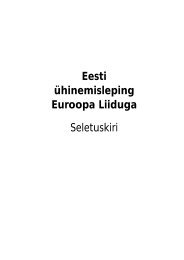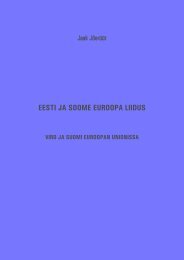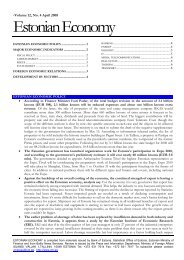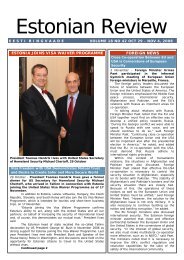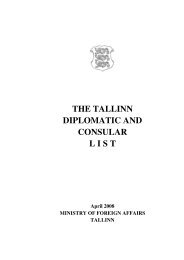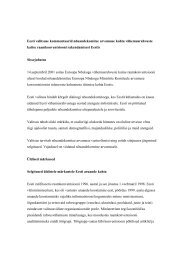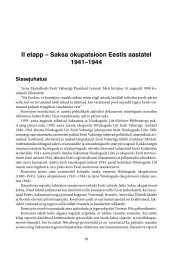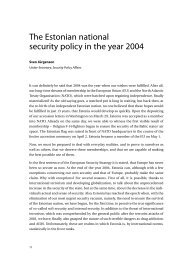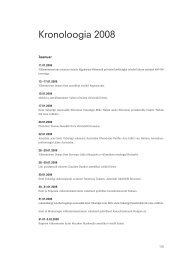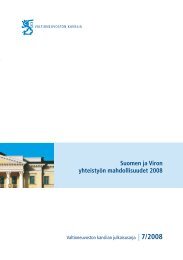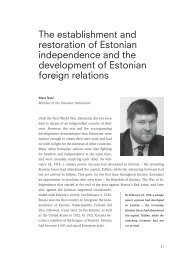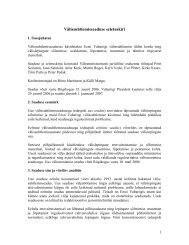Opportunities for Cooperation between Estonia and ... - Valitsus
Opportunities for Cooperation between Estonia and ... - Valitsus
Opportunities for Cooperation between Estonia and ... - Valitsus
Create successful ePaper yourself
Turn your PDF publications into a flip-book with our unique Google optimized e-Paper software.
APPENDIX 5<br />
GULF OF FINLAND AND THE BALTIC SEA<br />
Created approximately 10,000 to 15,000 years ago after the latest Ice Age,<br />
the Baltic Sea is one of the youngest seas in the world. At the same time,<br />
it is the world’s largest brackish water basin inhabited both by sweet-water<br />
<strong>and</strong> salt-water organisms. Being relatively shallow, the Baltic Sea is highly<br />
sensitive. In the late1950s, the state of the sea was still considered good.<br />
Subsequent changes have even had economic consequences on fishing,<br />
tourism <strong>and</strong> the provision of recreational services. At the same time, the risk<br />
of maritime accidents <strong>and</strong> the probability of environmental damage have been<br />
heightened.<br />
Many scientists have declared that today the Baltic Sea is the world’s most<br />
polluted sea. The biggest problem is eutrophication due to phosphates <strong>and</strong><br />
nitric compounds. Dense aquatic vegetation <strong>and</strong> its degradation processes<br />
decrease the oxygen content of sea water <strong>and</strong> its quality, which, in turn, has<br />
an adverse impact on the habitat of fish <strong>and</strong> other water fauna. According to<br />
scientific estimates, the Baltic Sea now contains four times more nitrogen <strong>and</strong><br />
eight times more phosphorous compared with the situation at the beginning<br />
of the 20th century. Additionally, 42,000 km2 of the seabed is practically<br />
biologically dead because of oxygen depletion. This type of area affects the<br />
food chain in the sea <strong>and</strong> may, according to researchers, even cause the entire<br />
ecosystem to collapse. Each summer, we can witness how sizeable portions of<br />
the Baltic Sea are unfit <strong>for</strong> swimming when the toxic blue-green algae <strong>for</strong>m<br />
blooms.<br />
Pollution from agriculture, <strong>for</strong>estry, industry, transport <strong>and</strong> shipping has pushed<br />
the Baltic Sea into a corner. The International Maritime Organisation (IMO) has<br />
declared the entire Baltic Sea, except <strong>for</strong> the Russian territorial waters, a highly<br />
sensitive sea area. Today, all the Baltic Rim countries, with the exception of<br />
Russia, are members of the European Union.<br />
Aside from the pollutants from l<strong>and</strong>, one of the biggest risks is posed by<br />
shipping. Carriage by sea accounts <strong>for</strong> nearly half of all the goods transported<br />
to <strong>and</strong> from the Baltic Rim countries. Over the past ten years, the volume of<br />
shipping in the Baltic has increased 50%. According to 2007 statistics, over<br />
60,000 vessels entered or exited the Baltic Sea during one year. At any given<br />
time, over 1,350 freighters are in transit in the Baltic. Simultaneously, there are<br />
150 to 200 oil tankers moored in some 20 ports around the Baltic Sea.<br />
36



